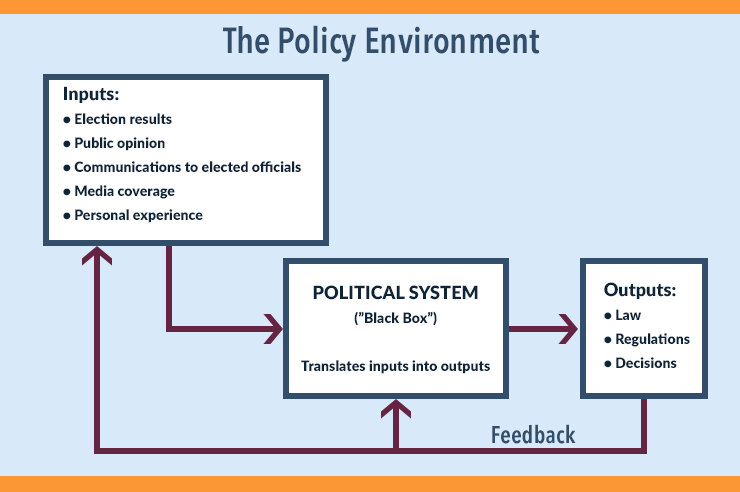Main Content
Lesson 2 : The Policy Making System, History and Structure of Policy Making in the United States
Public Policy System

In addition to the policy stages model, another model was proposed by Easton (1965). He proposed that we should think the policy process as a system. He theorized that they key components of this system were:
- the environment in which the policy is made;
- inputs into the policy system;
- the "black box" in which the decisions actually get made;
- the outputs, or products of the decision-making process; and
- feedback, in which outputs' observable results are evaluated and used to improve or terminate programs if they are failing.
Figure 2.2 illustrates Easton's model. We summarize the elements of enviornment, input, and outputs in the following sections. More information can be found in the Birkland book (2020).
What is the Policy Environment?
According to Easton (1965), four environments influence policy making: structural, social, economic, and political environments.
The formal structural environments include the framework of the US government including the separation of powers and federalism as well as other traditions and legal structures in place that establish the rules of policymaking.
The social environment involves nature and composition of the population and society that will influence policy. For example, the United States is experiencing a growth in the 65+ age group and among the oldest citizens (ages 85 and older). This demographic trend is more pronounced in some other countries. Nonetheless, there are implications for decision-making. As the number of elderly citizens increases—even if not explosively—greater demand will be placed on such programs as Social Security and Medicare. Decision-makers in the policy system will need to respond to this trend in some way.
The political environment is about how the public feels about various issues and how will that impact the ability to set and enact policy. Policy makers use public opinion polling to assess their political and policy options.
The economic environment includes the growth of the economy, the distribution of wealth in a society, the size and composition of industry sectors, the rate of growth of the economy, inflation and the cost of labor and raw materials. Aspects of the economic environment gain the greatest attention from policy makers and the public.
What Are the Inputs?
The inputs are public demands made upon the political system and the supports of the system itself. Public opinion is one input. A key question is the extent to which public opinion can affect decision-making. Over time, there has been much research on this subject. Publications appearing in the 1980s and 1990s (and even earlier) suggest that public opinion can affect actual policy decisions. Pages and Shapiro's (1983) study illustrates how public opinions can affect public polices.
Page's and Shapiro's Study on Public Opinion (1983)
Page and Shapiro (1983) conducted a study (using results gathered over a lengthy period of time) that examined public opinion polling, which spoke to people's policy preferences. They then developed measures of policy change enacted by various governmental agents.
We see that if public opinion moves by 6%–7%, then the direction of actual policy change is not much affected. Let's say that support for increased spending on schools increased by 6% over a five-year period. If that was the case and government policy changed, 53% of the time it was in the direction of public opinion (congruent)—but it was not congruent with the increased support 47% of the time. In other words, there wasn't that much of an effect on government policy toward education.
On the other hand, if public opinion changed by 20%–29% (say, in favor of a more muscular defense policy), 86% of the time the government policy changed along with the public's mood change. This, of course, suggests that public opinion is serving as an input in the decision-making process.
| Size of opinion change | Direction of policy change: Congruent | Direction of policy change: Non-congruent |
|---|---|---|
| 6%–7% | 53% | 47% |
| 8%–9% | 64% | 36% |
| 10%–14% | 62% | 38% |
| 15%–19% | 69% | 31% |
| 20%–29% | 86% | 14% |
| 30%+ | 100% | 0% |
What Are Outputs?
The political system’s outputs are basic statements of public policy that reflect the government's intent to do something. Outputs are the results of the demands and supports. Outputs are conceptualized in a concrete form that can be easily measured.
Outputs can range from spending money to criminalizing behavior. Laws, regulations, and public services are outputs. For example, services provided by the government in regulating everything from commercial aviation to nuclear power plants are outputs.
References
Easton, D. (1965). A systems analysis of political life. New York, NY: John Wiley & Sons.
Gilens, M., & Page, B. I. (2014). Testing theories of American politics. Perspectives on Politics, 12, 564–581.
Page, B. I., & Shapiro, R. Y. (1983). Effects of public opinion on policy. American Political Science Review, 77, 175–190.
